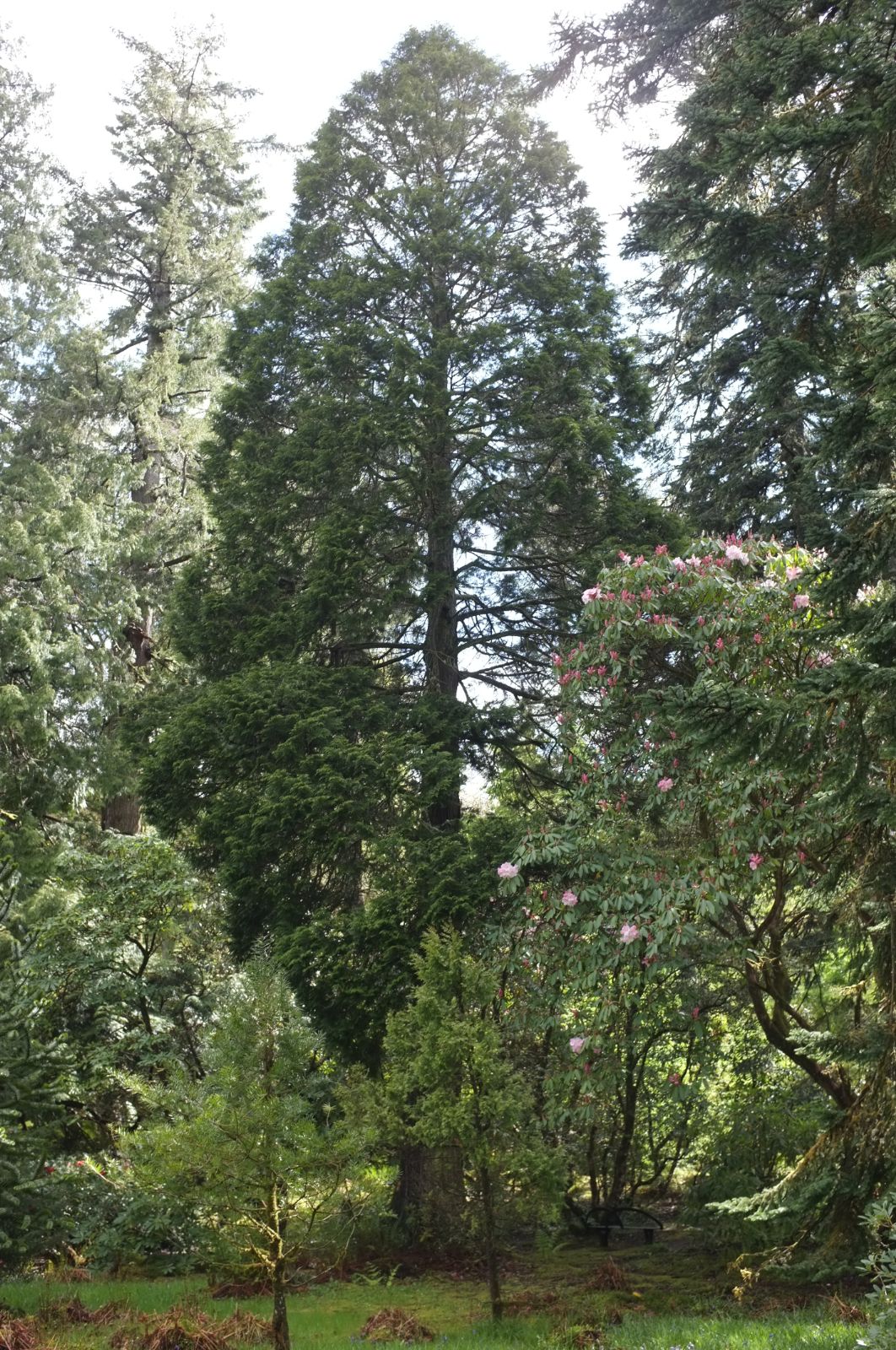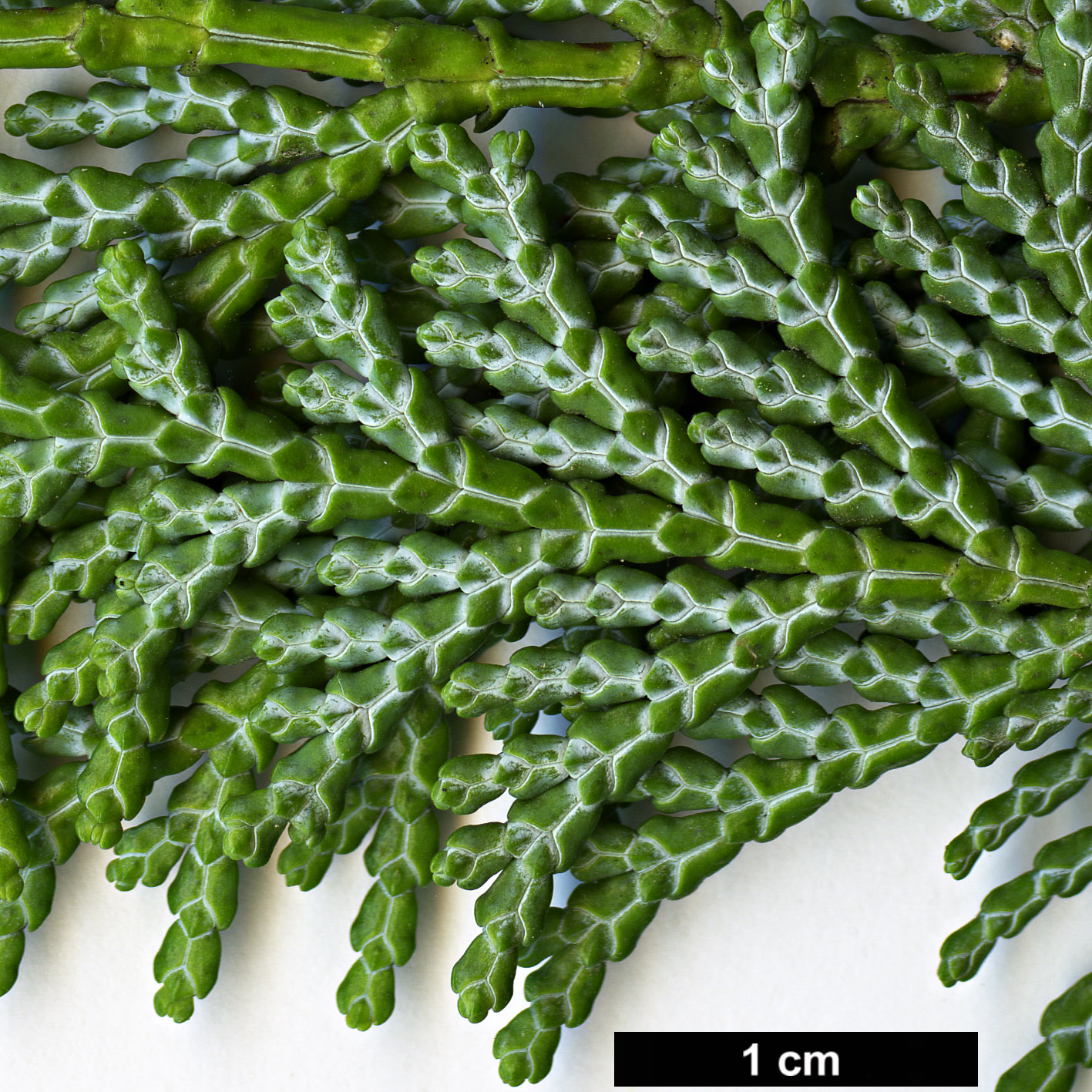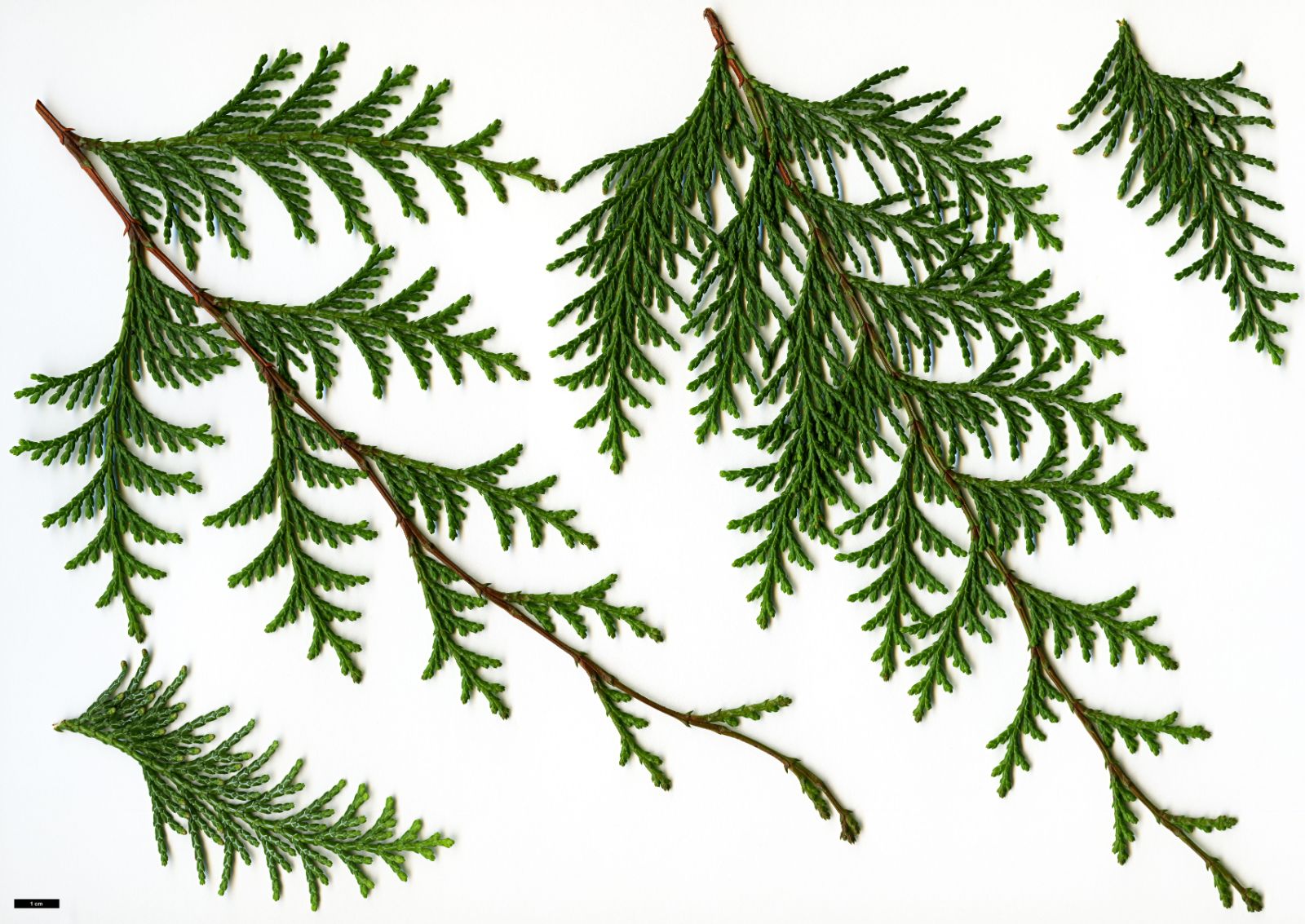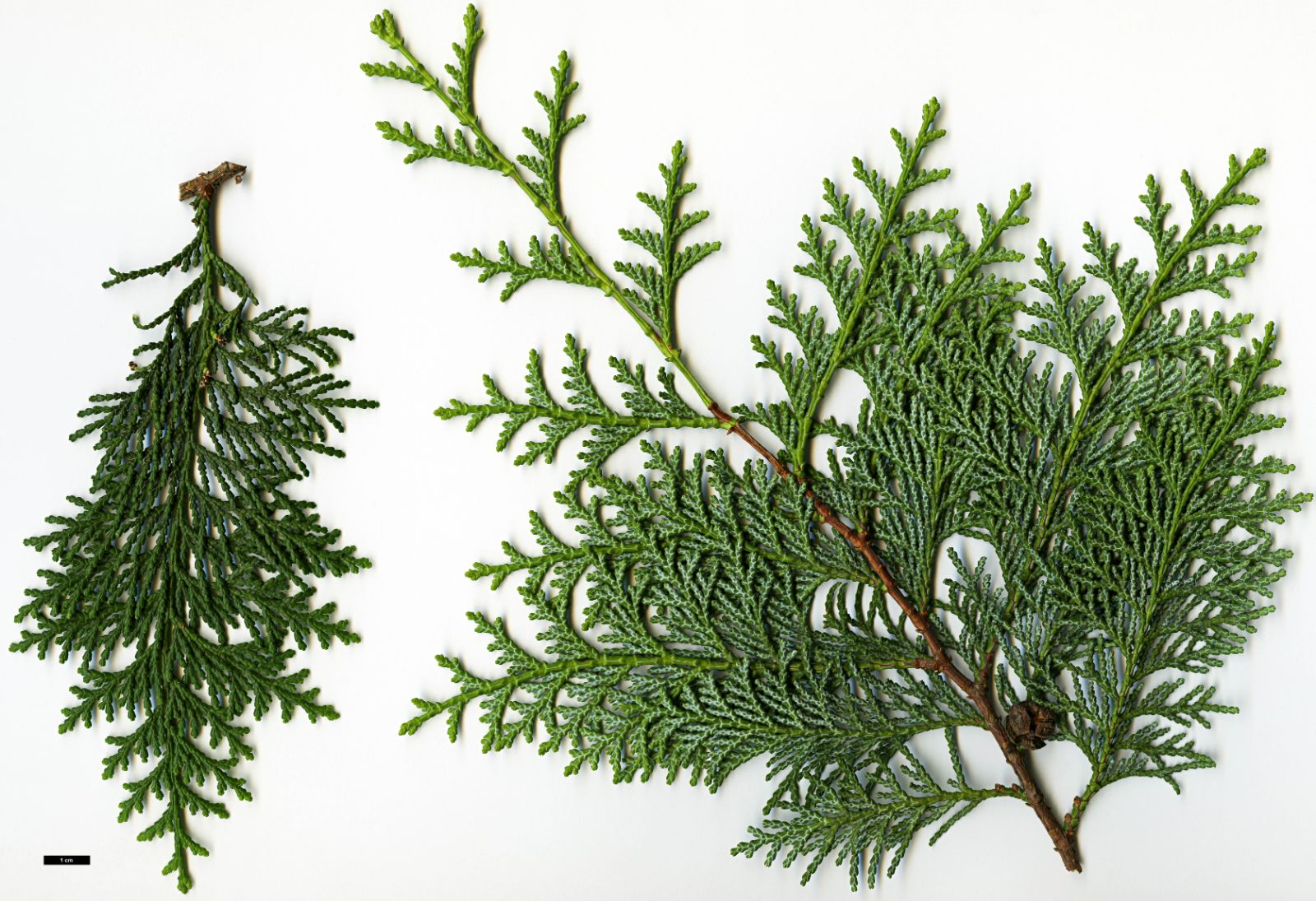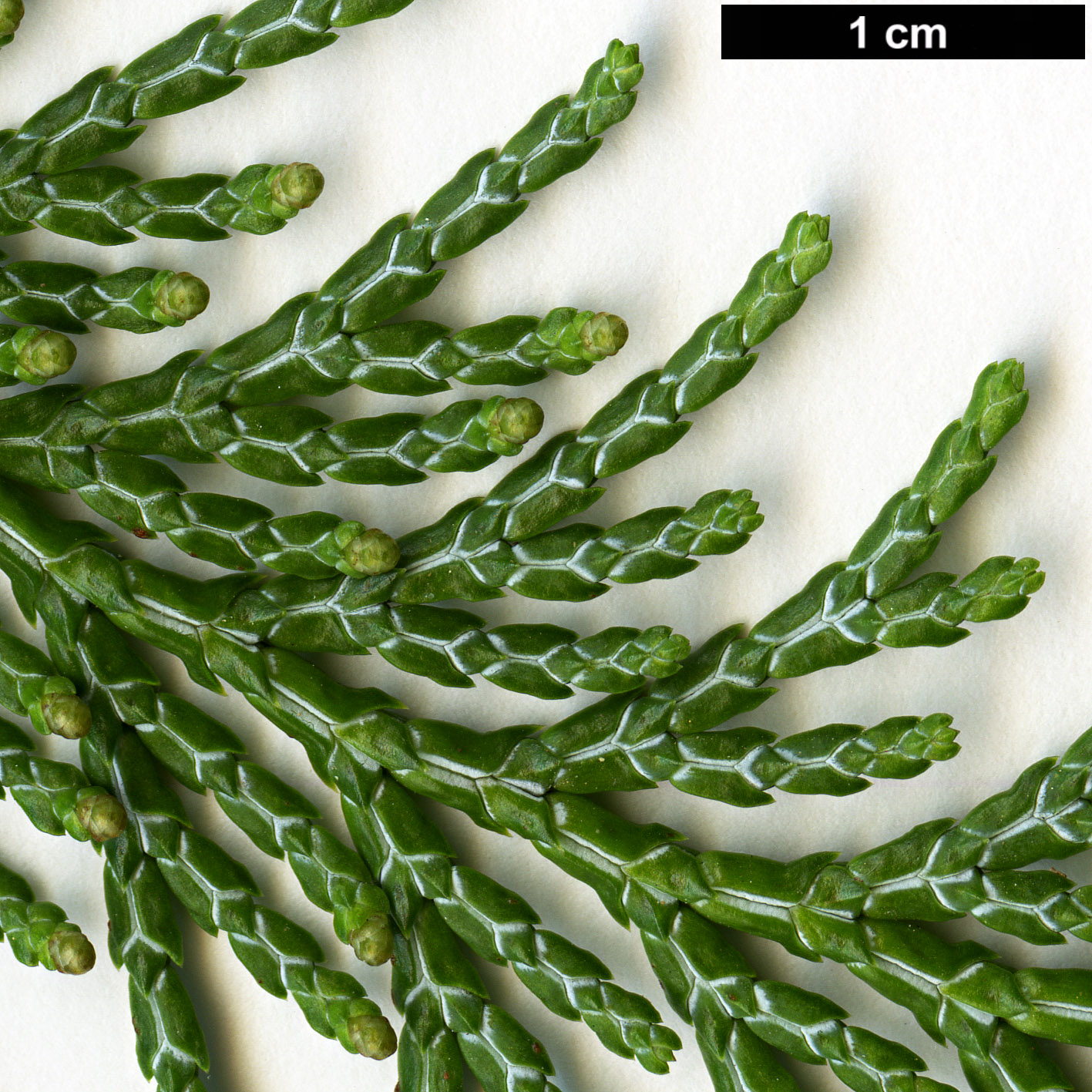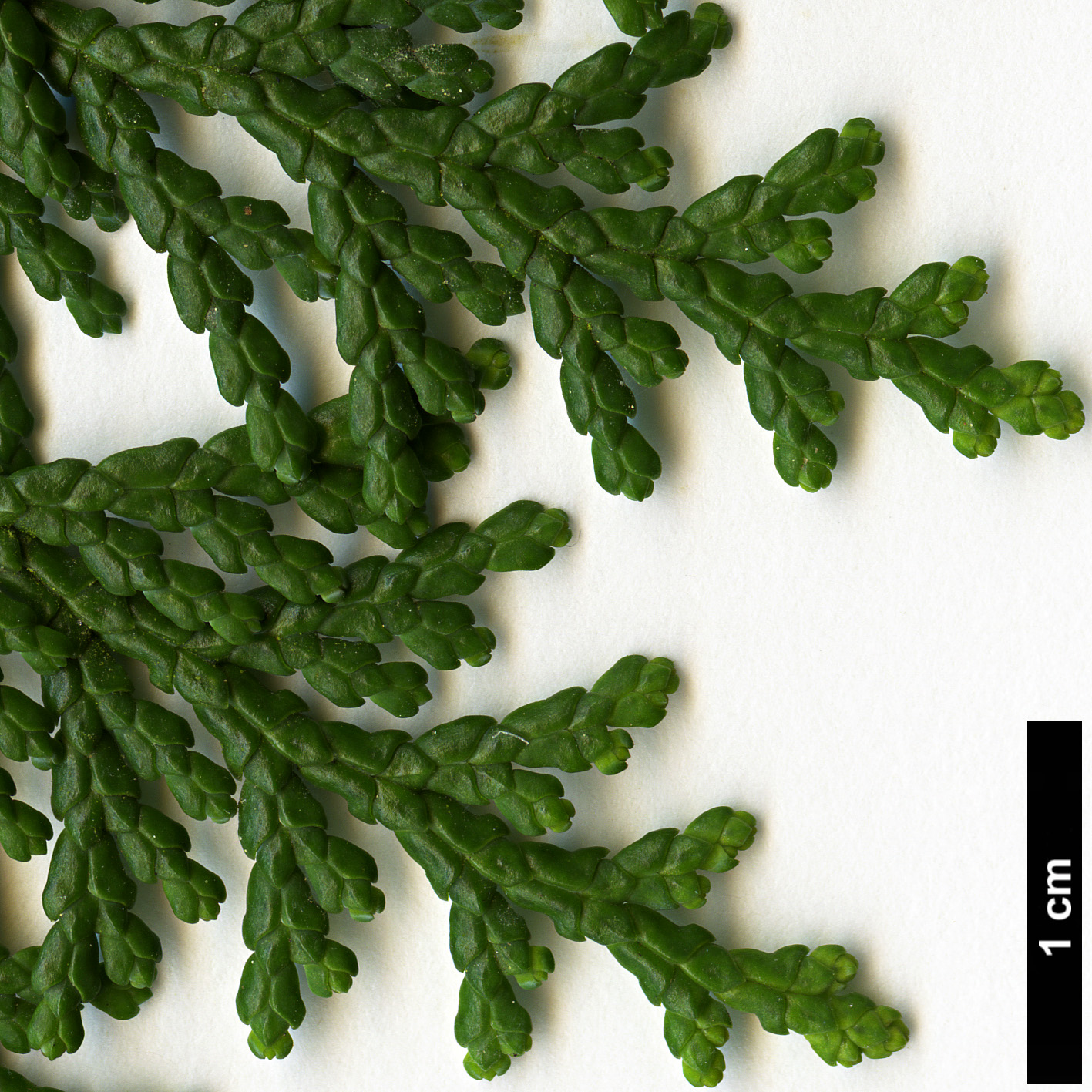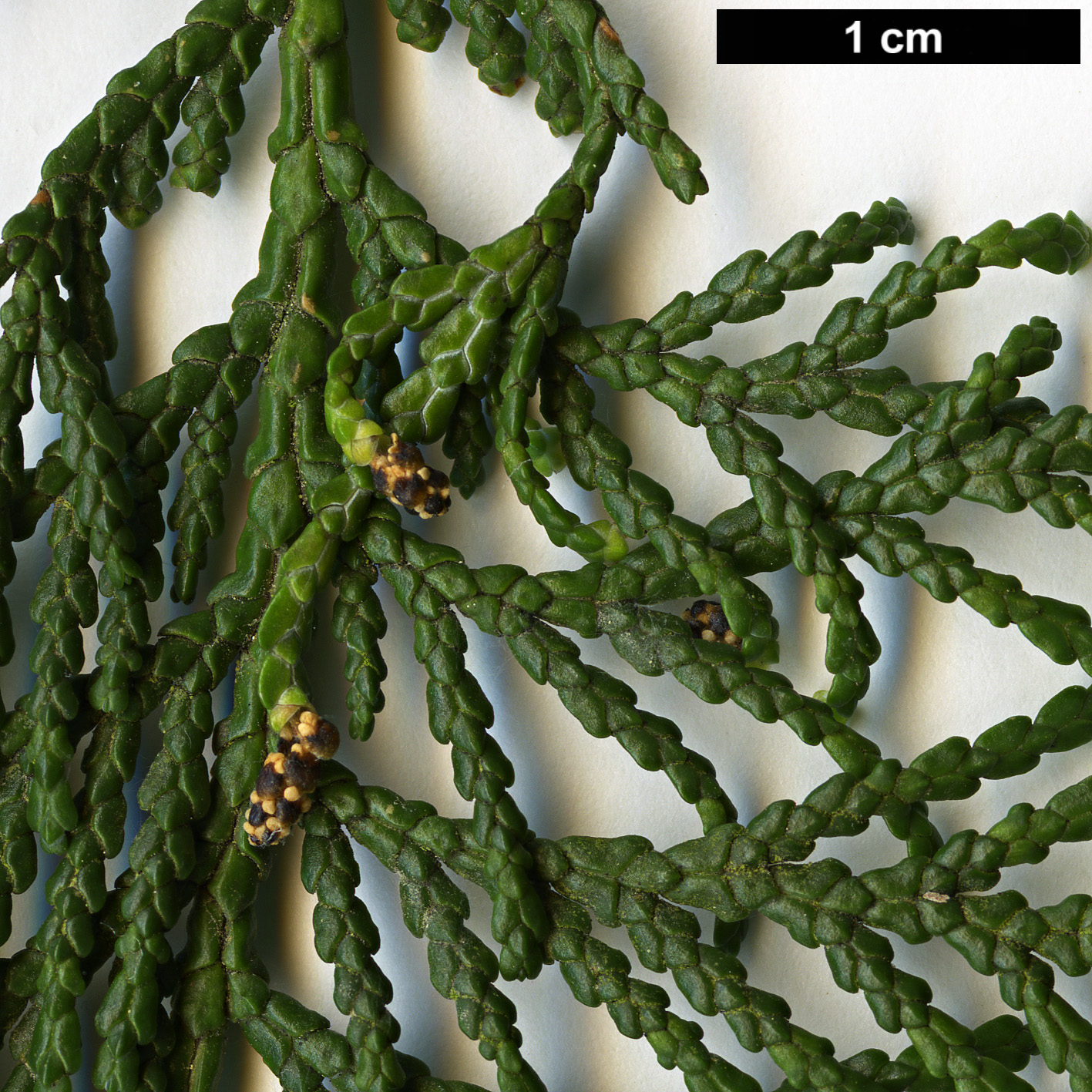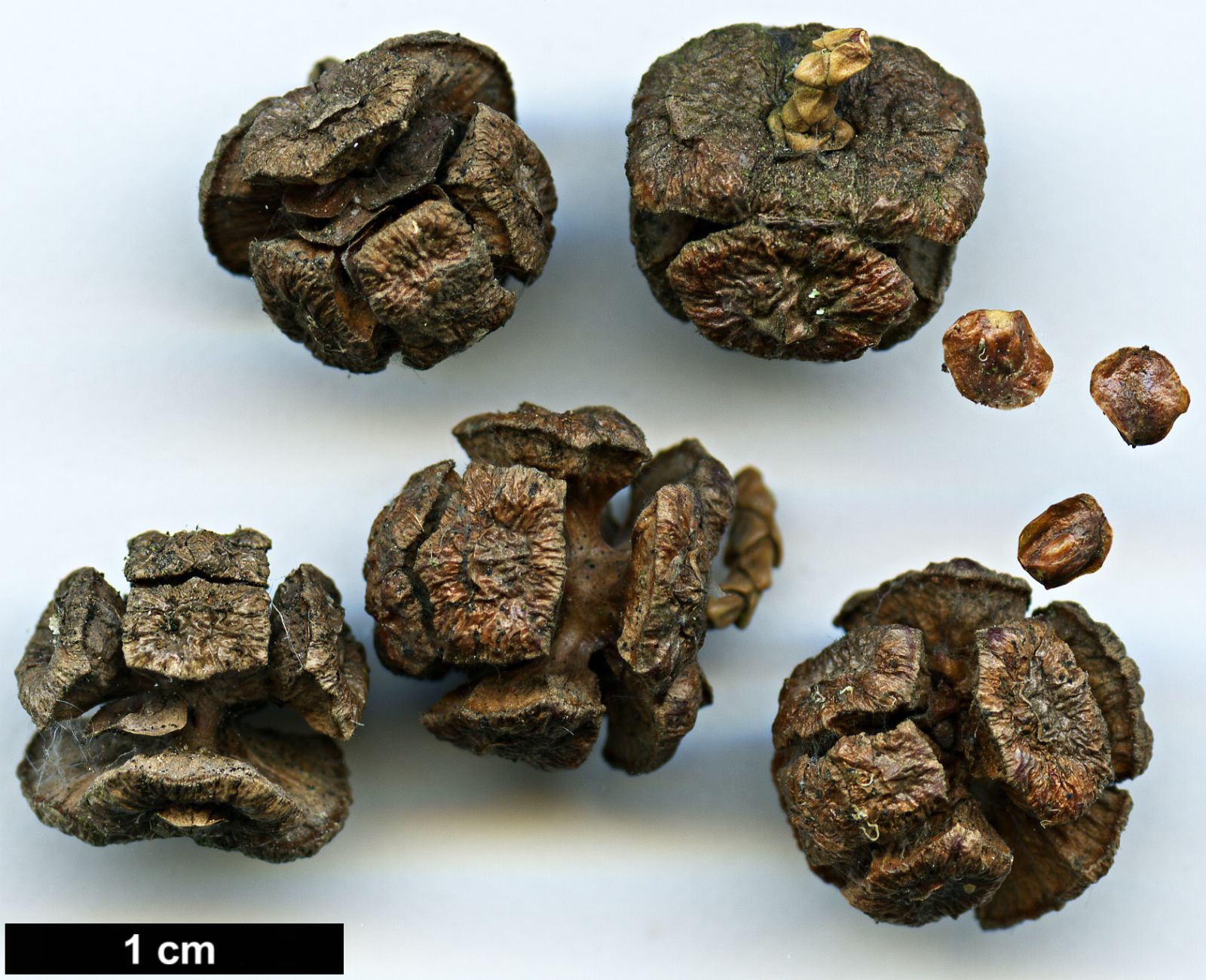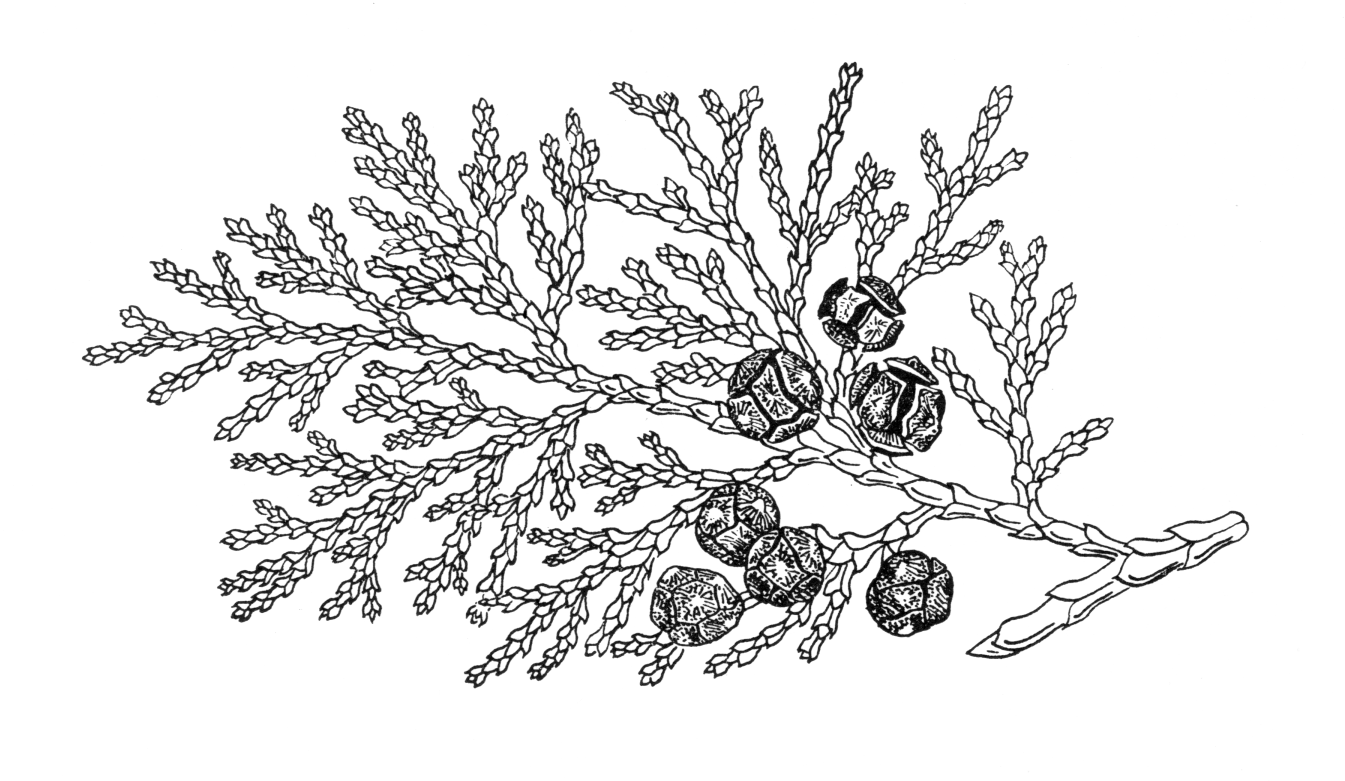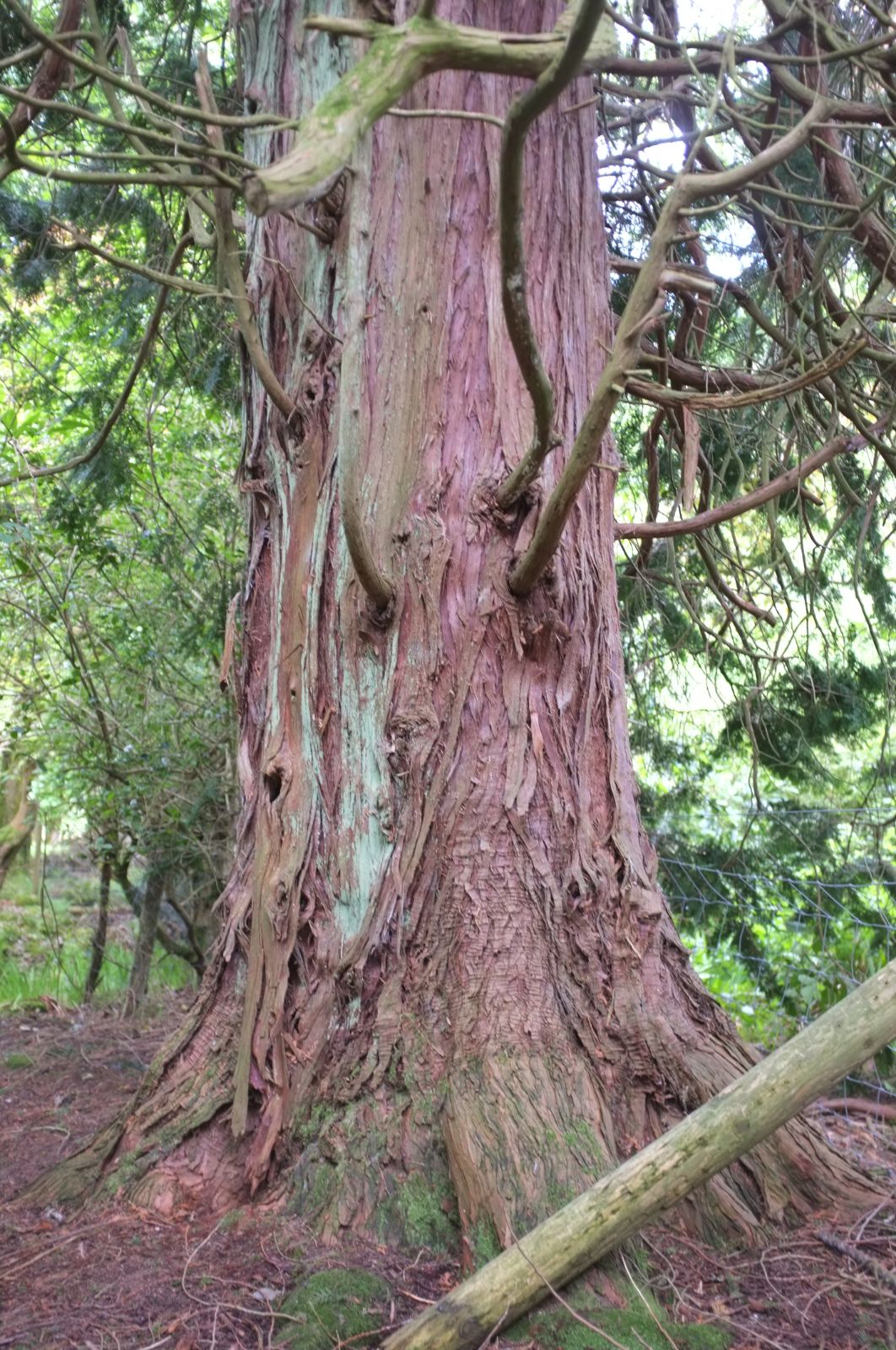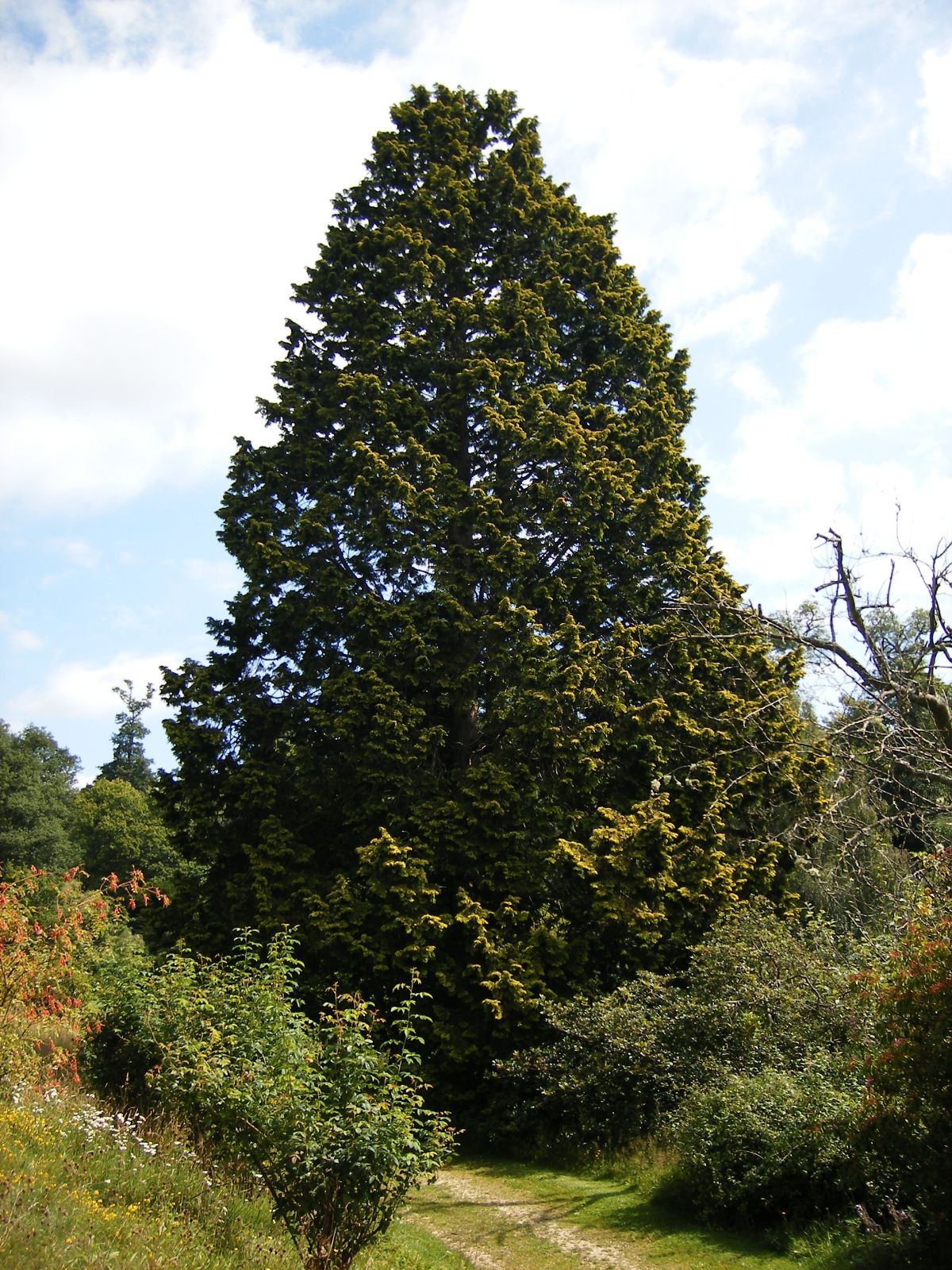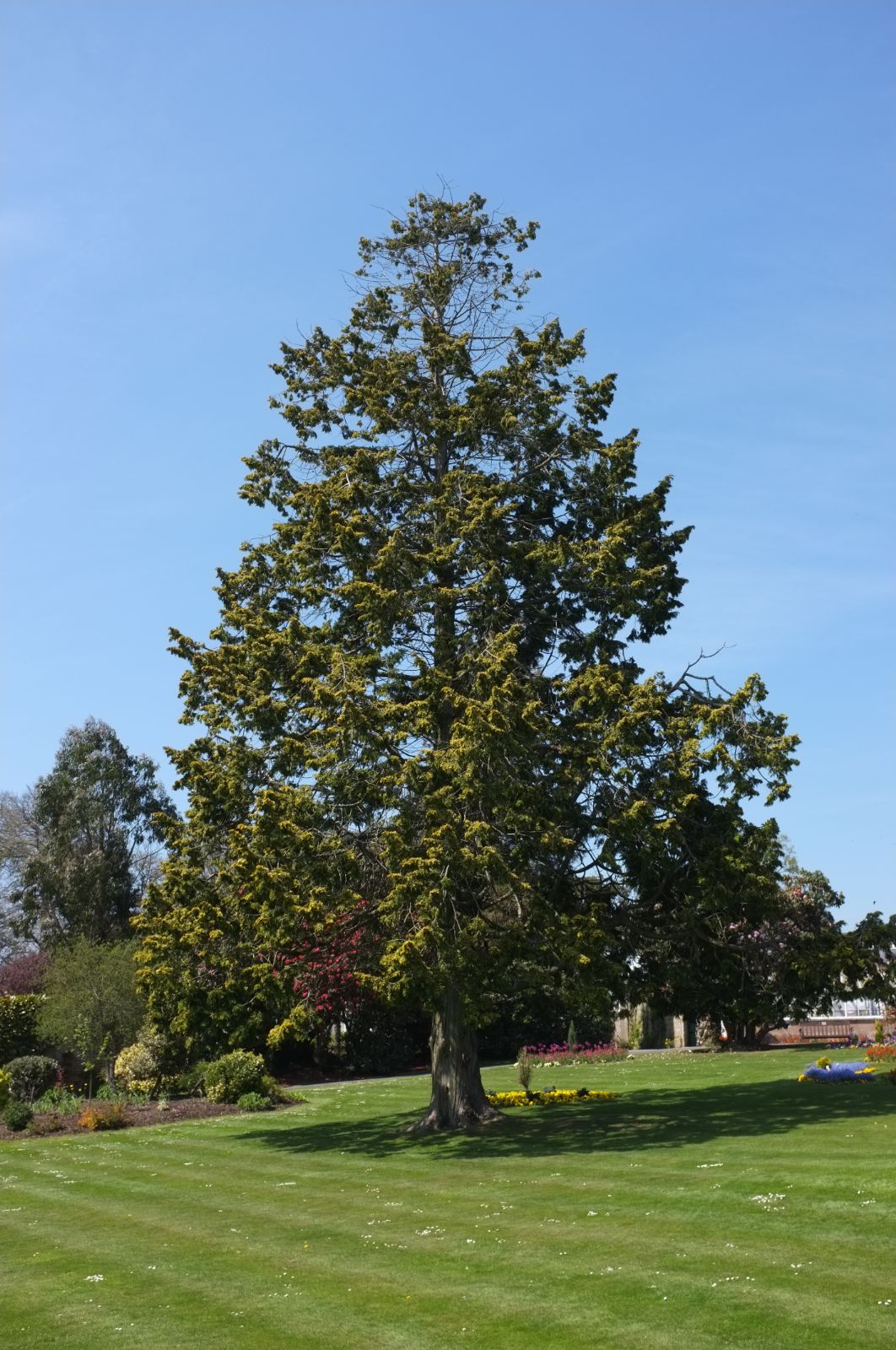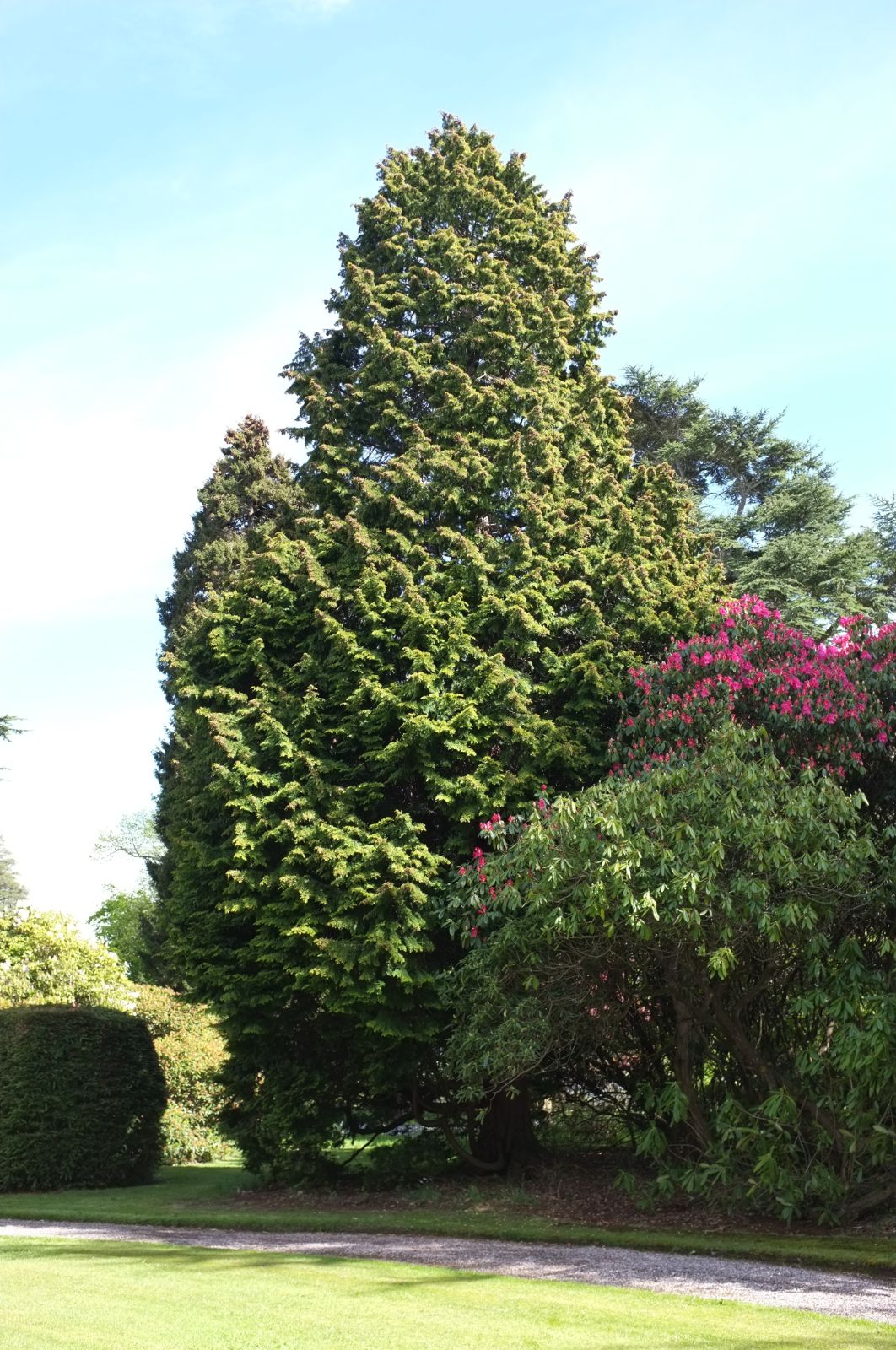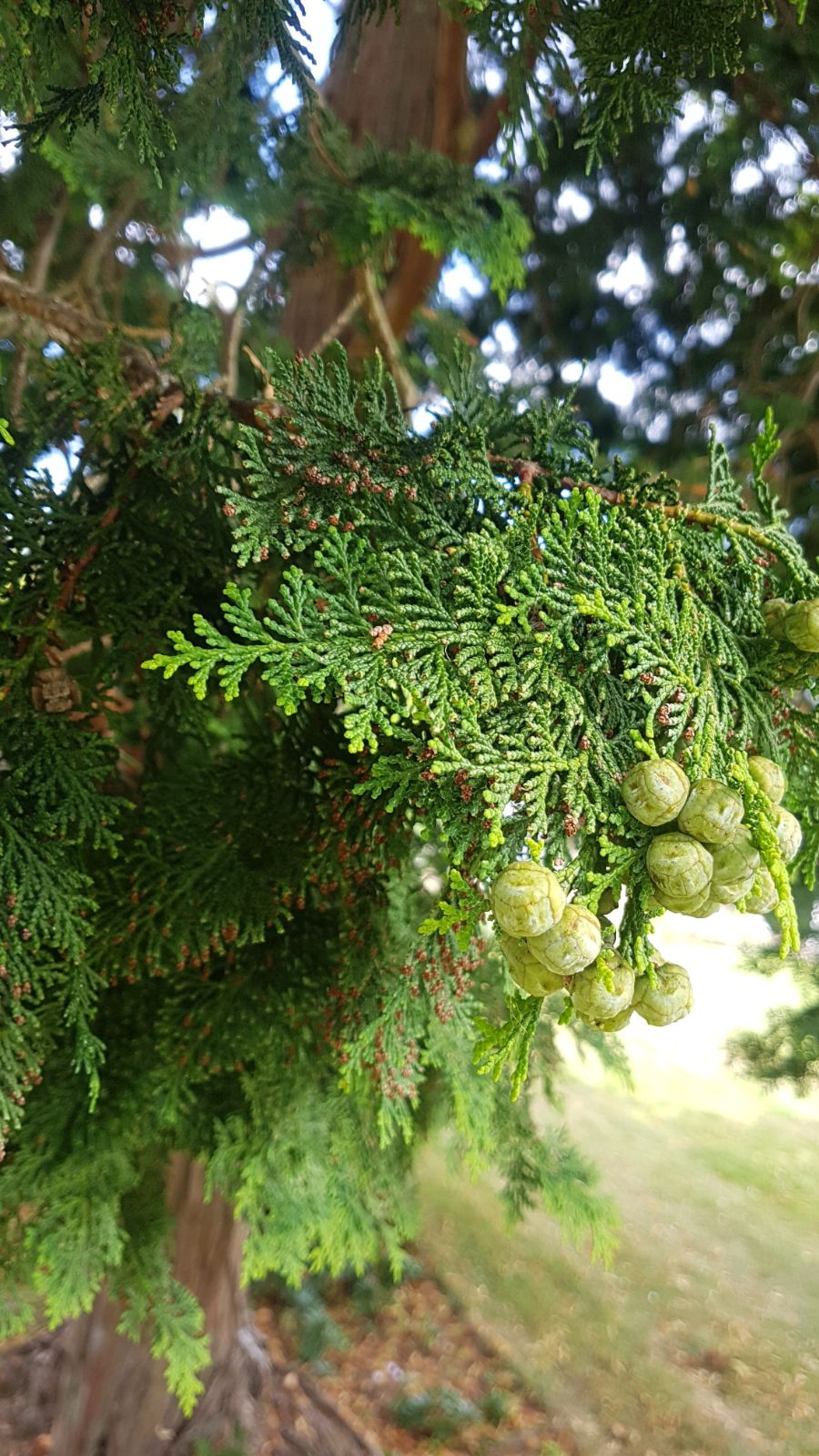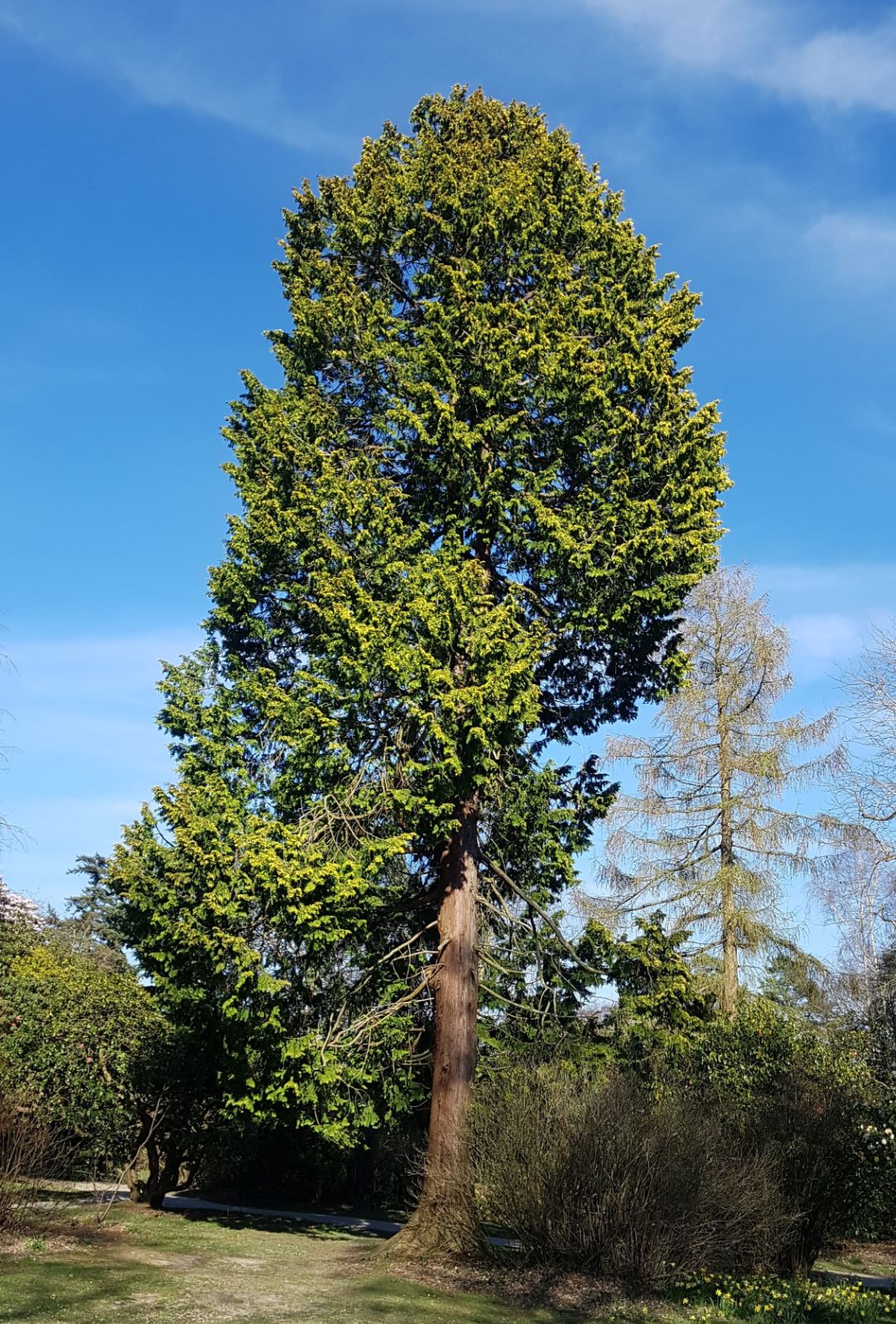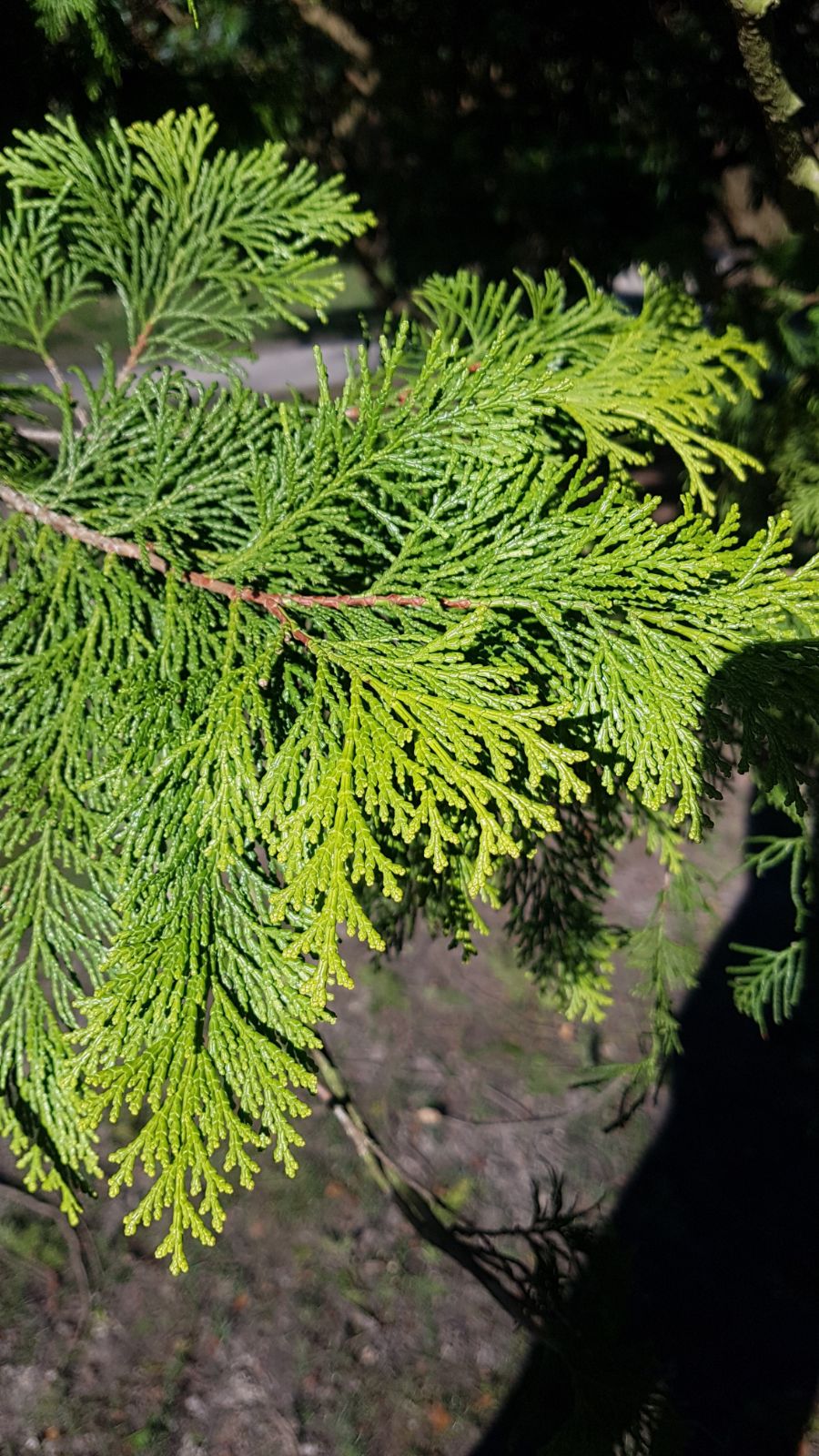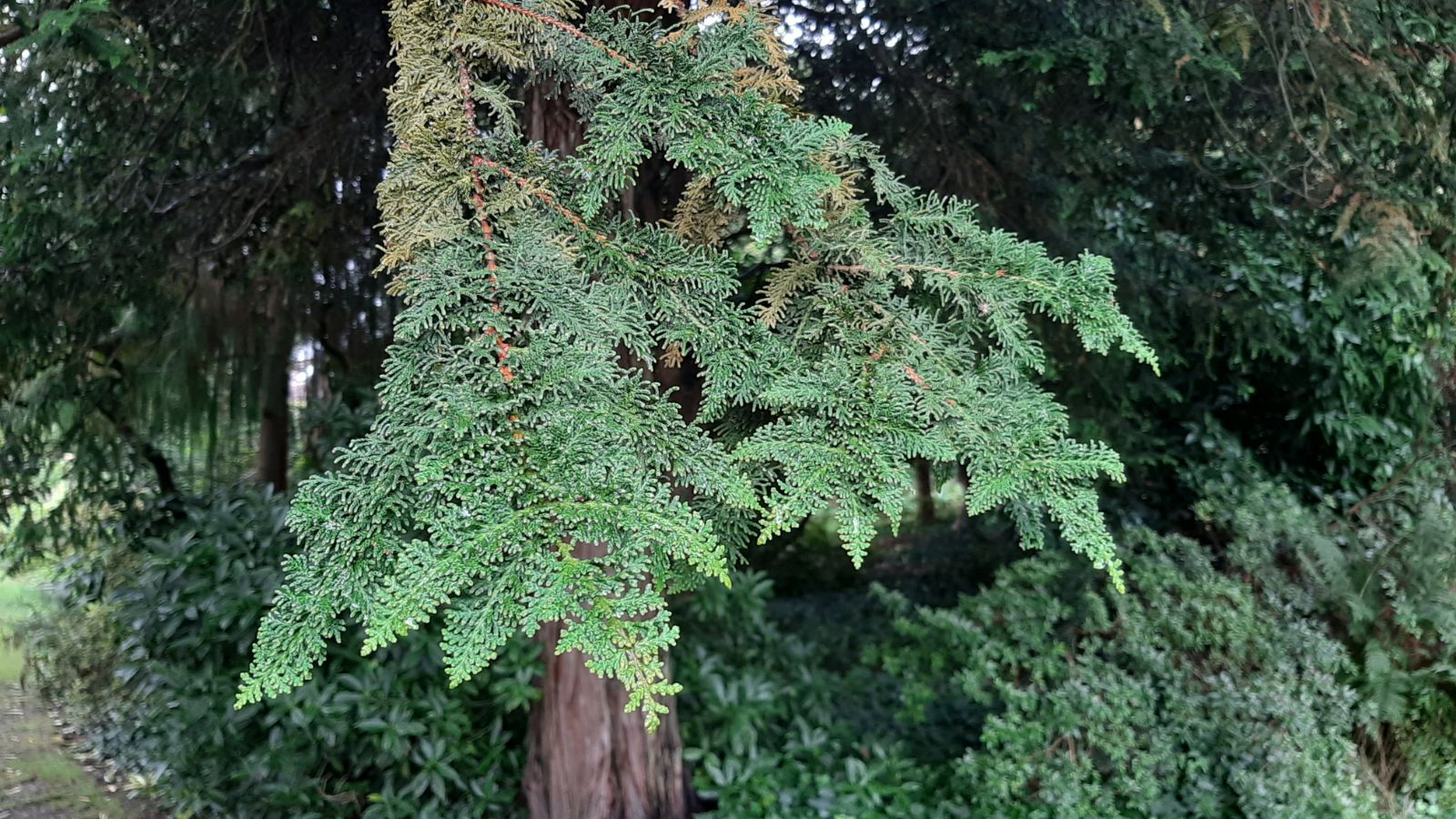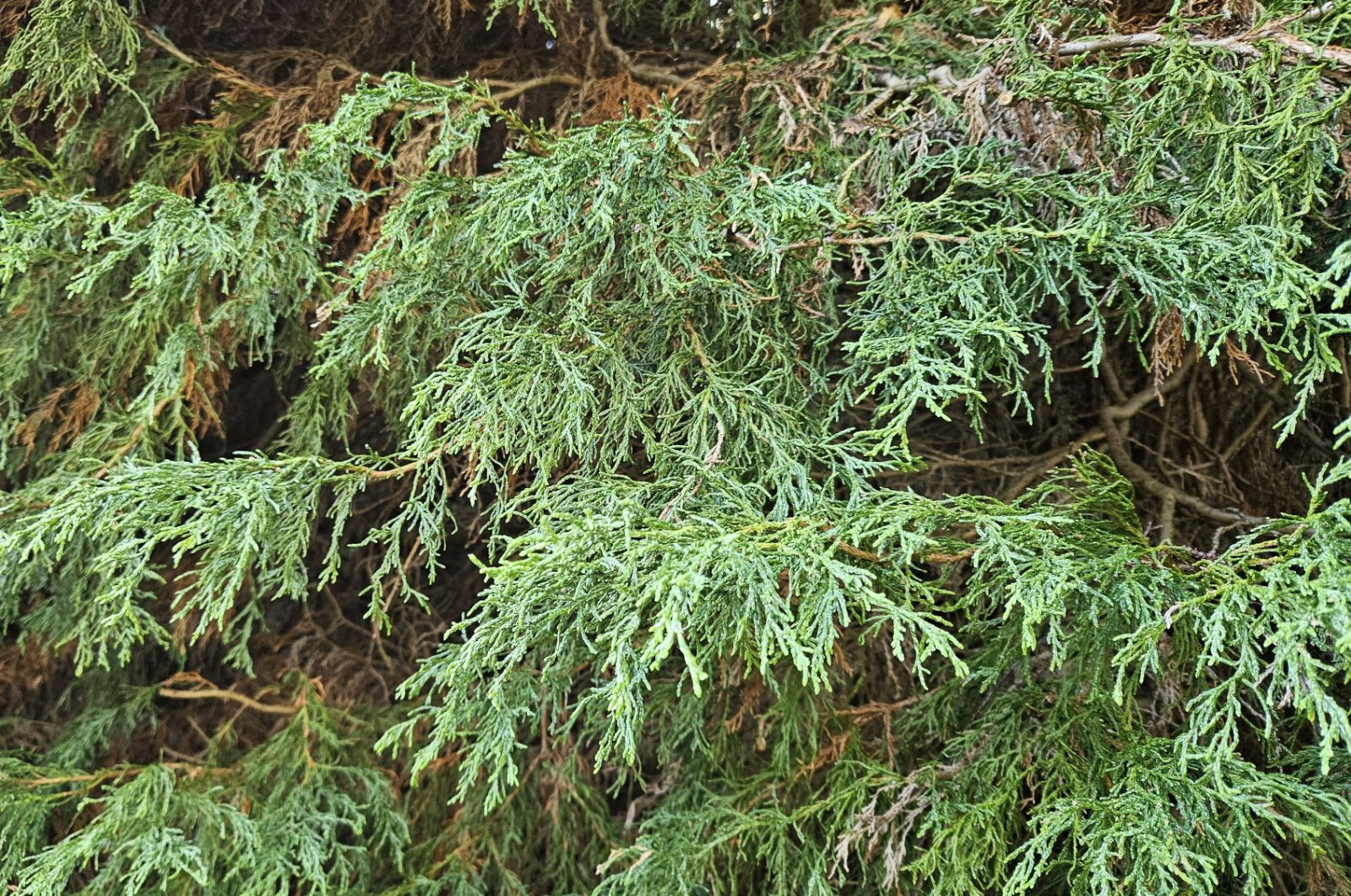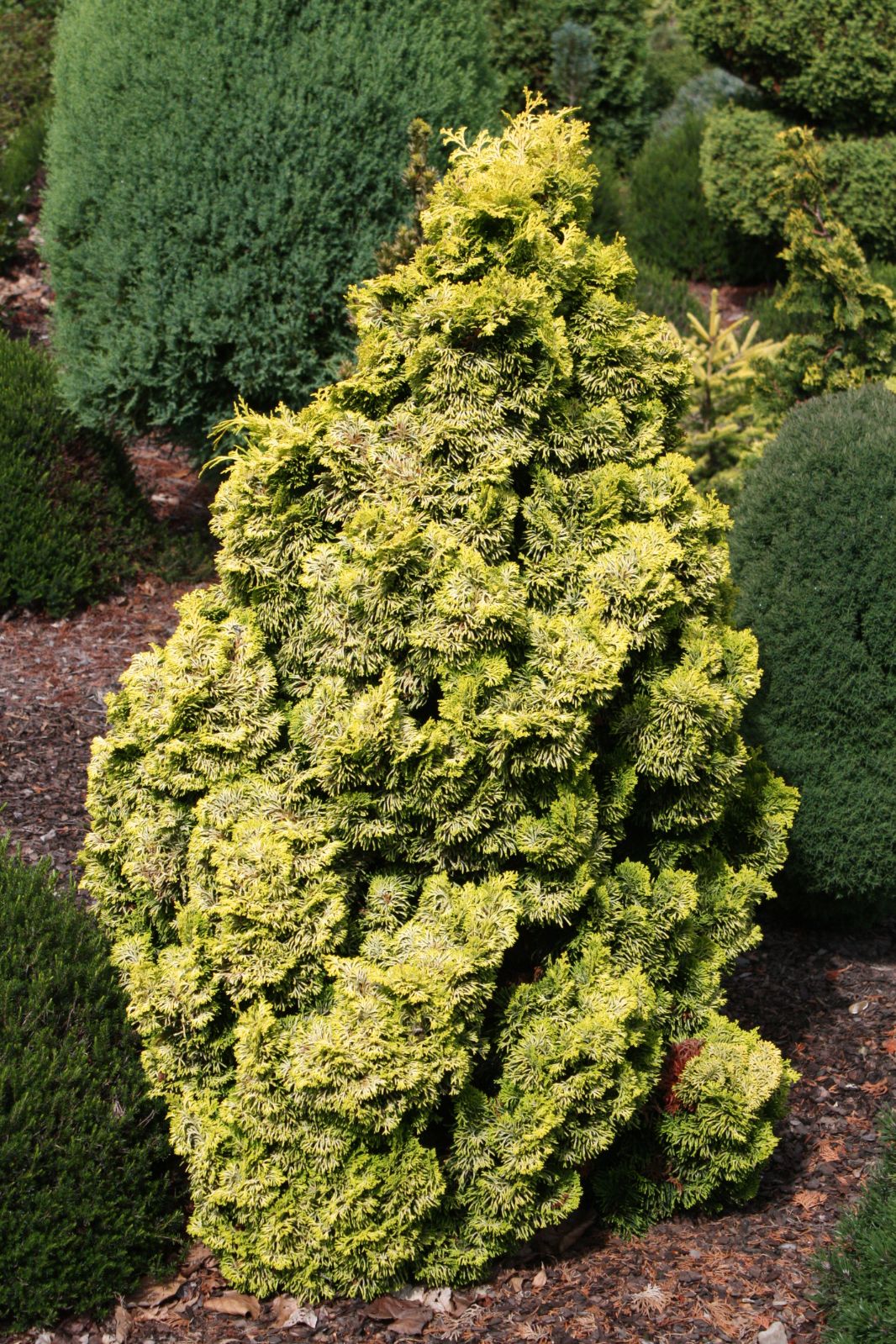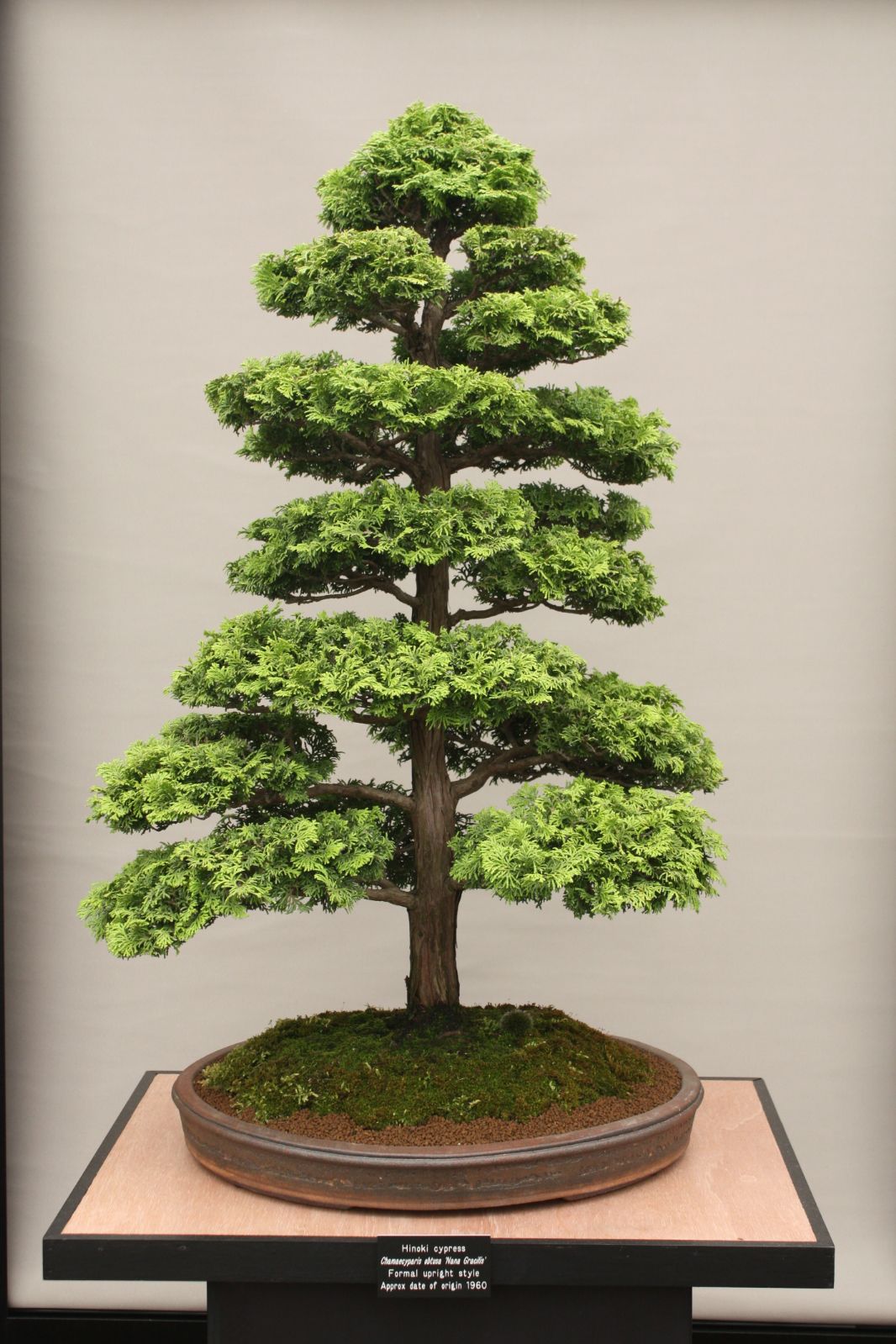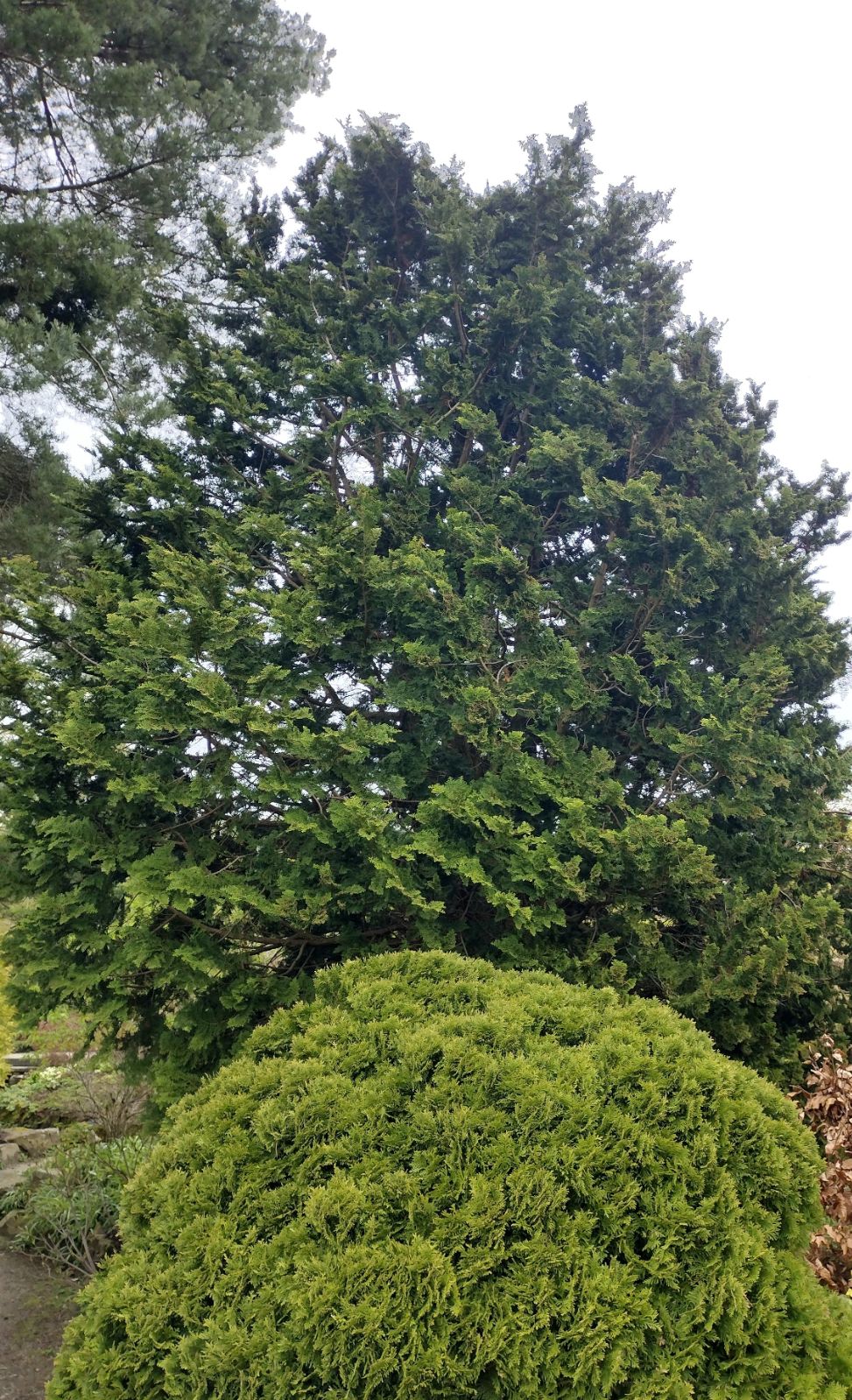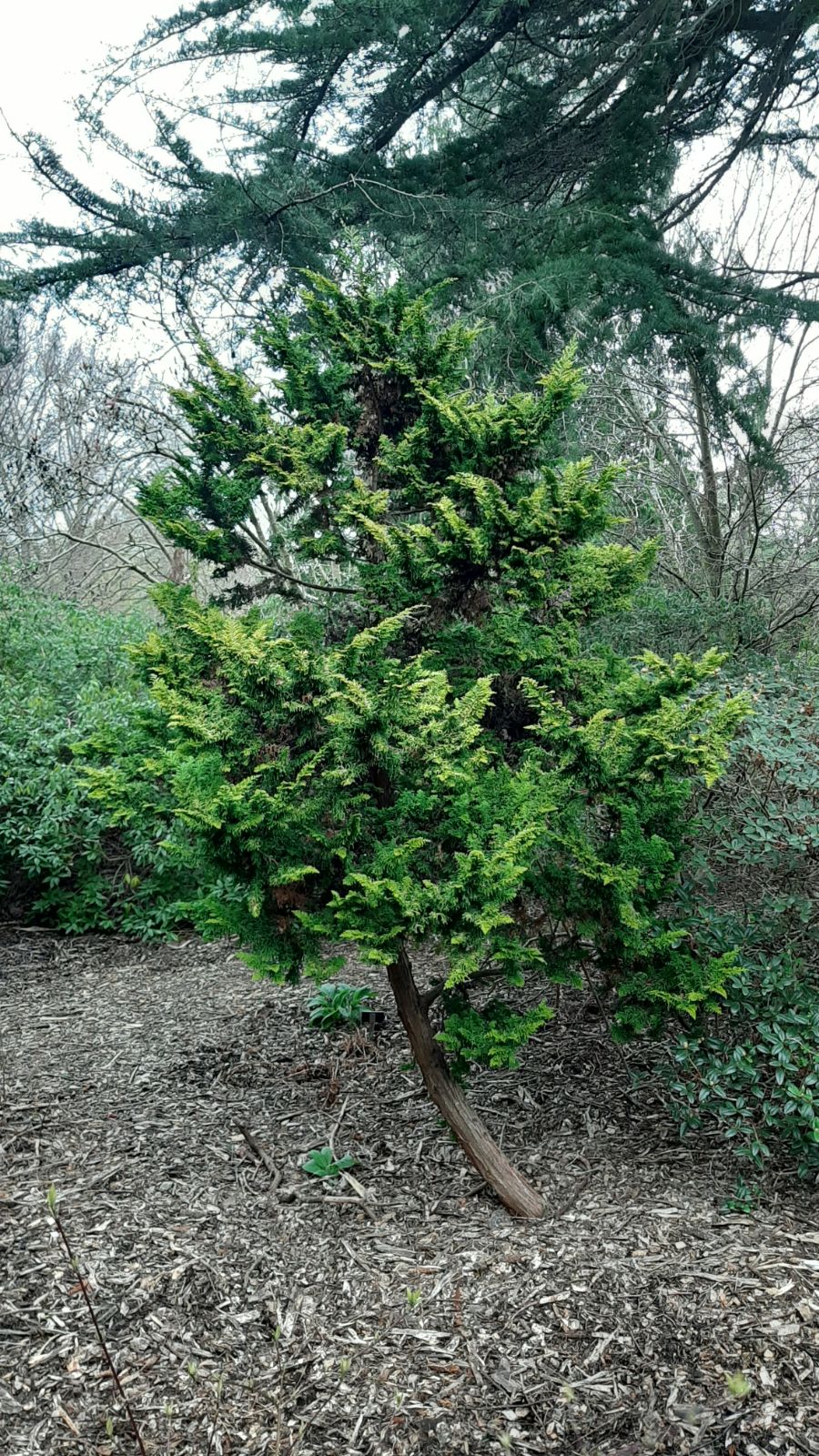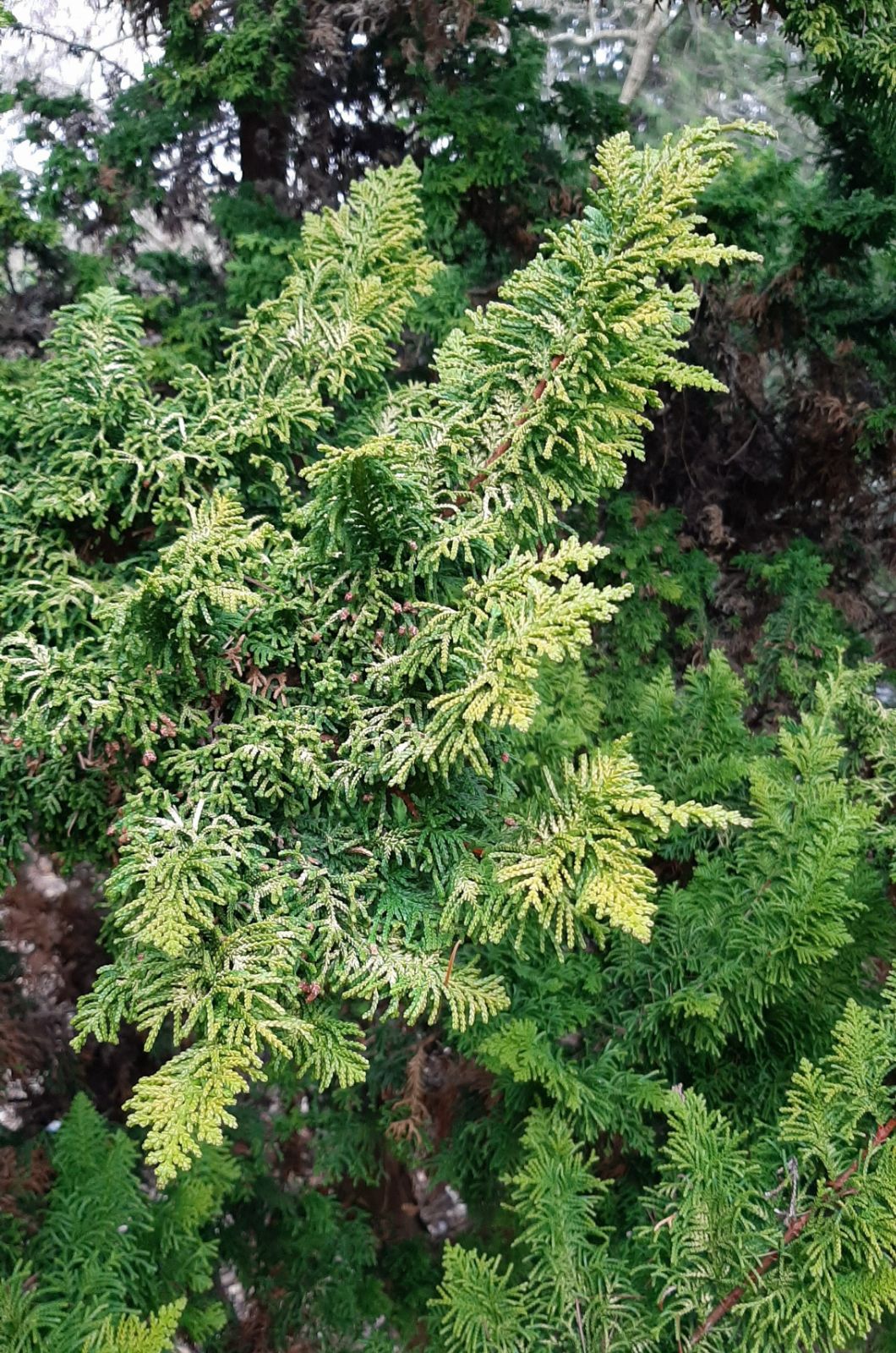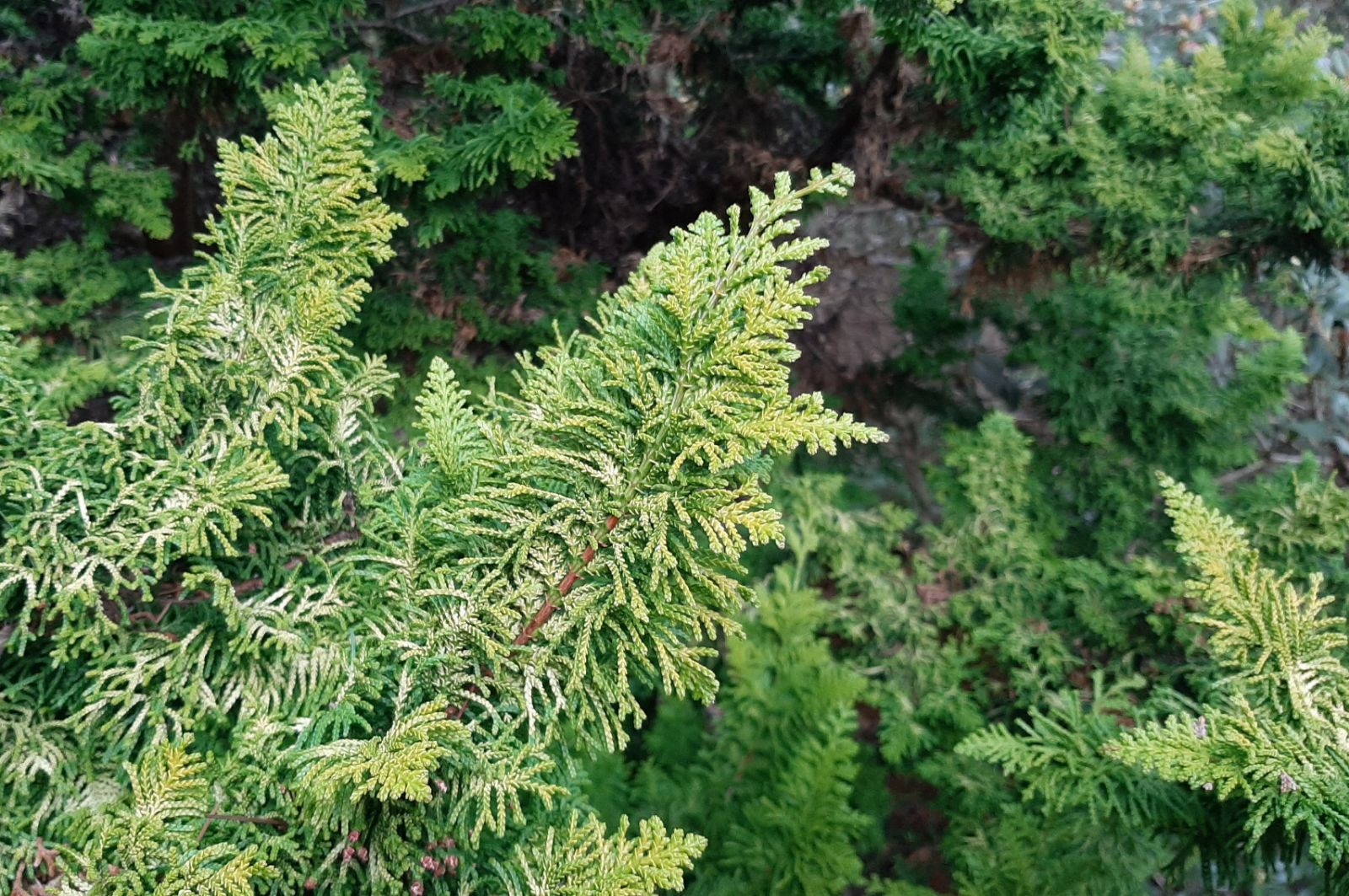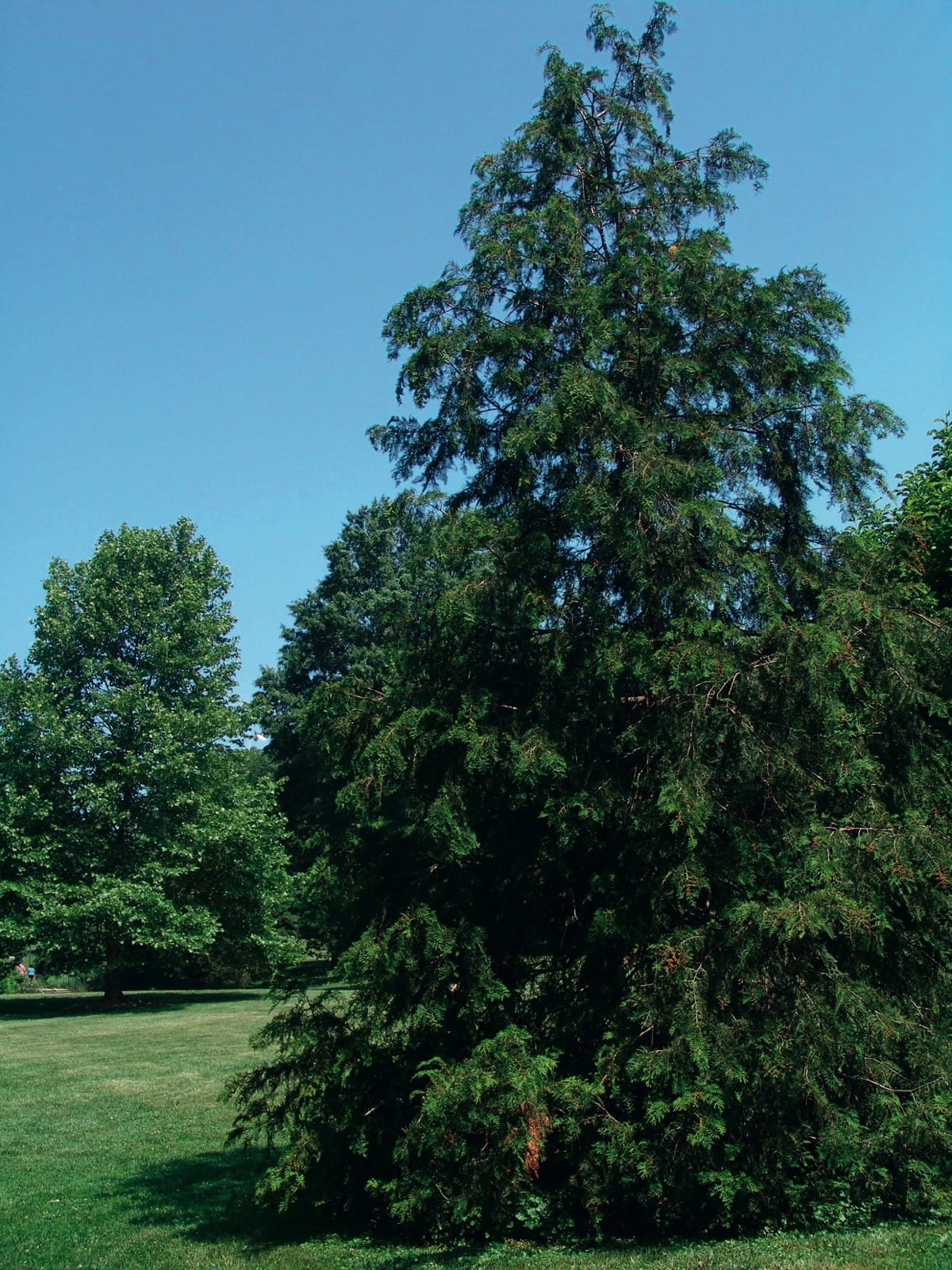Chamaecyparis obtusa
Credits
Article from Bean's Trees and Shrubs Hardy in the British Isles
Article from New Trees by John Grimshaw & Ross Bayton
Recommended citation
'Chamaecyparis obtusa' from the website Trees and Shrubs Online (treesandshrubsonline.
Genus
Common Names
- Hinoki Cypress
Synonyms
- Retinispora obtusa Sieb. & Zucc.
- Cupressus obtusa (Sieb. & Zucc.) K. Koch
A tree 100 to 120 ft high in Japan, with a reddish-brown trunk 3 or 4 ft in diameter. Branches horizontal or depressed, bearing the successive ramifications in two opposite horizontally spreading rows. The final leaf-bearing subdivisions are, leaves and all, about 1⁄16 in. wide, and rather flattened. Leaves scale-like, not glandular, of two sizes, the lateral pairs the larger, about 1⁄12 in. long, somewhat boat-shaped, clasping the smaller ones above and beneath; all are blunt, thick, and fleshy, rich green above, paler beneath. The margin of every leaf beneath is defined by a thin line of glaucous bloom, which gives a variegated appearance. Cones solitary on a short branch, 1⁄3 in. diameter, brown; scales usually eight, the surface slightly hollowed towards the centre, where there is a small projection.
Native of Japan, and long cultivated there for its beauty and for its timber; introduced by John Gould Veitch in 1861. It yields the most valuable of Japanese timbers. As an ornamental tree in the British Isles it is very pleasing. It does not grow very fast, and the largest trees in the country are only about 70 to 80 ft high, but well-grown specimens are very graceful in their soft feathery branching. It likes a good moist soil, but will not thrive where there is much lime. With age and on poor soils it is apt to get thin, but this can to some extent be remedied by clipping off the ends of the shoots to induce denser branching – a process it bears very well. It is one of the favourite subjects of the Japanese for dwarfing. It is well distinguished from C. pisifera and C. lawsoniana by its blunt, round-ended leaves, and the thin glaucous line just beyond the margins beneath.
The biggest specimen so far recorded in the British Isles grows near to the National Pinetum, Bedgebury, Kent; this is 83 ft high on two stems, the thickest 81⁄2 ft in girth (1966). The handsomest specimen found by A. F. Mitchell also grows in Kent; this is at Benenden, and measures 70 × 61⁄2 ft (1958). Others recorded are: Bicton, Devon, 71 × 71⁄4 ft (1957); Killerton, Devon, 68 × 71⁄2 ft (1964); Westonbirt, Glos., 67 × 41⁄2 ft (1963); Petworth House, Sussex, 77 × 43⁄4 ft (1961).
Numerous varieties are in cultivation, of which the following are the most important:
From the Supplement (Vol. V)
specimens: Bedgebury House, Kent (near but not in National Pinetum), 87 × 83⁄4 + 6 ft and 80 × 71⁄4 + 71⁄2 ft (1977); Benenden House, Kent, 74 × 71⁄4 ft (1970); Leonardslee, Sussex, Hill Garden, 74 × 43⁄4 ft (1980); Petworth House, Sussex, 75 × 51⁄4 ft (1976); Cowdray Park, in Garden, 50 × 73⁄4 ft (1982); Westonbirt, Glos., Loop, 68 × 43⁄4 ft (1975) and, in Willesley Drive, 72 × 4 ft (1981); Bicton, Devon, the tree measured in 1968 was blown down and the largest in the collection is now 82 × 51⁄4 + 5 ft (1977); Killerton, Devon, 79 × 61⁄2 ft (1983); Tregrehan, Cornwall, 50 × 63⁄4 ft (1979); Powis Castle, Powys, in the Wilderness, 72 × 5 ft (1981); Powerscourt, Co. Wicklow, Eire, near Lake, 75 × 61⁄4 ft (1980).
cv. ‘Aurea’. – specimens: Cowdray Park, Sussex, 56 × 71⁄4 ft at 3 ft (1982); Chelwood Vachery, Sussex, 55 × 33⁄4 ft (1981); Bicton, Devon, 62 × 63⁄4 ft and 56 × 43⁄4 ft (1983); Margam Park, W. Glam., 56 × 31⁄2 ft (1979).
cv. ‘Crippsii’. – specimens: Bagshot Park, Surrey/Berks., 66 × 41⁄4 ft (1982); Tilgate, Sussex, 62 × 51⁄4 ft (1974); Nymans, Sussex, 66 × 41⁄4 ft (1985); Sheffield Park, Sussex, 59 × 51⁄4 ft (1982); Westonbirt, Glos., 48 × 31⁄4 ft (1976) and 46 × 31⁄4 ft (1975).
cv. ‘Filicoides’. – specimens: Wakehurst Place, Sussex, 35 × 31⁄4 ft (1979); Endsleigh, Devon, 40 × 63⁄4 ft at 1 ft (1977).
† cv. ‘Kosteri’. – Unless trained, this makes a spreading bush to about 4 ft high. It is a picturesque specimen, with bright green foliage in twisted sprays.
cv. ‘Lycopodioides’. – specimens: Nymans, Sussex, 59 × 3 ft (1985); Leonardslee, Sussex, 66 × 41⁄2 ft (1979); Endsleigh, Devon, 42 × 53⁄4 ft (1977); Caerhays Castle, Cornwall, 52 × 51⁄4 ft and 52 × 43⁄4 ft (1984); Tregrehan, Cornwall, 62 × 5 ft (1979); Tregothnan, Cornwall, 54 × 51⁄2 ft (1985); Stonefield, Argyll, 35 × 43⁄4 ft in 1931, now 52 × 81⁄2 ft (1981).
† cv. ‘Mariesii’. – Slow-growing, of conical form, with yellowish or creamy young foliage, becoming greener in winter. It makes a rather skimpy specimen unless the leading shoots are pruned. Also known as ‘Nana Albo-variegata’ and ‘Nana Argentea’.
cv. ‘Nana. – This cultivar and ‘Nana Gracilis’ appear out of alphabetical order near the top of page 598.
† cv. ‘Nana Aurea’. – A slow-growing bush, attaining 6 ft in time, its foliage in fan-shaped sprays, golden yellow in a sunny position, otherwise yellowish green. An old cultivar, introduced from Japan.
cv. ‘Nana Gracilis’. – This is inclined to produce strong-growing reversion shoots, especially if grafted, and these should be cut out. Otherwise it may grow to an uncharacteristic height – almost 30 ft at Stourhead.
† cv. ‘Nana Lutea’. – Dwarfer than ‘Nana Aurea’ and brighter gold, holding its colour well in winter. Raised by Messrs Spek of Boskoop and put into commerce in the early 1960s. A more vigorous sport from this has been named ‘Goldilocks’.
† cv. ‘Pygmaea’. – A low-growing shrub to about 2 ft high but much more in width, with bright green, fan-shaped sprays becoming bronzed in winter. Humphrey Welch remarks that it may become upright and 8 ft or so high if grafted.
cv. ‘Sanderi’. – The status of this cultivar, thought by some to be a juniper, or even a distinct genus, has long been a subject of controversy. However, analysis of its resin by L. J. Gould has shown that it is almost beyond doubt a juvenile form of Thuja orientalis (Bot. Journ. Linn. Soc., Vol. 77, pp. 217–21 (1978)).
† cv. ‘Tempelhof’. – A broad, compact bush with vividly green foliage in fan-shaped sprays, eventually 9 ft or so high. The original plant grew in the Tempelhof nurseries of Messrs Konjin near Boskoop.
cv. ‘Tetragona Aurea’. – This well-known cultivar varies considerably in size according to the vigour of the material used for propagation or, in the case of grafted plants, according to the vigour of the root-stock used. It develops its characteristic colour only when grown in a sunny position.
specimens: R.H.S. Garden, Wisley, Surrey, 38 × 53⁄4 ft at 3 ft (1982); Grayswood Hill, Haslemere, Surrey, 38 × 3 ft + 21⁄2 ft (1982); National Pinetum, Bedgebury, Kent, pl. 1925, 19 ft × 1 ft (1970); Nymans, Sussex, 31 × 31⁄4 ft (1980); Lydhurst, Sussex, 41 × 31⁄4 ft (1980); Bicton, Devon, 42 × 2 ft (1977); Tregrehan, Cornwall, 49 × 33⁄4 ft (1979); Dyffryn Gardens, near Cardiff, 33 × 21⁄4 ft (1979).
From New Trees
Chamaecyparis obtusa (Siebold & Zucc.) Endl.
Hinoki Cypress
This species was described by Bean (B596, S167) and Krüssmann (K84).
'Aurea'
Young shoots golden yellow. A Japanese garden tree, introduced by Fortune in 1860. There is an example in the Italian Garden at Bicton, Devon, measuring 52 × 6 ft (1957).
'Crippsii'
Coloured similarly to ‘Aurea’, but of a richer shade; very pleasing as a small tree of dense, very elegant habit. Raised by Cripps’ nursery, Tunbridge Wells, around the turn of the century. The largest tree recorded was planted at Tilgate, Sussex, in 1905 and now measures 50 × 4{1/4} ft (1961). There are several other examples in the south of England approaching that size, e.g. Westonbirt, Glos., 42 × 2{3/4} ft (1966), and Nymans, Sussex, 44 × 3{1/2} ft (1966).cv. ‘Filicoides’ – Habit dense; branching very close, the ultimate divisions short, much crowded, and not so flattened as in the type. Introduced from Japan by J. G. Veitch in 1861. An old specimen at Scorrier House, Cornwall, is 47 ft high with a girth of 4{1/4} ft (1959). One at Wakehurst Place, Sussex, measures 35 × 2{1/2} ft (1964).
'Lycopodioides'
Branching irregular, not strictly in two rows, the ultimate branchlets much thicker, more four-sided, and less compressed than in the type. Like many Japanese plants, it was introduced almost simultaneously (in 1861) by Fortune and by J. G. Veitch. Although often stated to be of dwarf habit, there are specimens ranging from 37 to 46 ft in height at: Westonbirt, Glos.; Scorrier House, Coldrenick, and Tregrehan, Cornwall; Bicton, Devon; Nymans, Sussex; Linton Park, Kent; and Wansfell, Ambleside, Westm.
'Nana'
A very slow-growing bush, ultimately 3 ft or so high and more wide; leaves lustrous blackish green; sprays concave, arranged in horizontal tiers. Introduced from Japan by Siebold.
'Nana Gracilis'
One of the finest medium-dwarf conifers, growing 8 to 10 ft high; foliage blackish green. A tree of great individuality, with a rugged aspect.
'Sanderi'
A curious little shrub of rounded, dense habit, with stiff, spreading, awl-shaped leaves, {1/8} to {1/6} in. long, of a very glaucous blue tint, and borne in decussate pairs. It was put into cultivation by Sander’s nursery as “Juniperus sanderi”, but originated in Japan and does not appear to be a juniper. Masters and Beissner were both of the opinion that it is a juvenile state of C. obtusa.'Stoneham'
A very slow-growing selection made by W.H. Rogers & Sons, UK, in the 1920s (Auders & Spicer 2012).
'Tetragona Aurea'
This has the branching of ‘Filicoides’, but the branchlets are thicker, more four-sided, and scarcely compressed. Young shoots yellow. Although slow-growing it is by no means dwarf as the following measurements show: Bicton, Devon, 36 × 2 ft (1967); Sindlesham, Berks., 30 × 1{1/2} ft (1959); Nymans, Sussex, 29 × 3 ft (1966); Wakehurst Place, Sussex, 27 × 1{1/2} ft (1965); Leonardslee, Sussex, 25 × 1{3/4} ft (1962). Its rate of growth is suggested by a tree in the National Pinetum, Bedgebury; planted in 1925 it measures 13 × {3/4} ft (1966).
var. formosana (Hayata) Hayata
Synonyms
C. taiwanensis Masam. & S. Suzuki
Var. formosana has shorter lateral (1–2 mm vs. 3 mm) and facial (1–1.2 mm vs. 1–1.5 mm) leaves when compared with the type variety. The leaves are typically thin with a subacute apex, while in the type they are thick with an obtuse apex. The cones of var. formosana are typically smaller (7–9 mm diameter vs. 8–12 mm) and the scales have a small central depression. Li & Keng 1994c, Fu et al. 1999e, Farjon 2005b. Distribution TAIWAN: Chiayi, Hualien, Ilan, Taichung, Taipei. Habitat Mesic, broadleaved forest or mixed forests between 1300 and 2800 m asl. Var. formosana can form pure stands or mixes with C. formosensis Matsum. at lower elevations. USDA Hardiness Zone 7. Conservation status Vulnerable. Illustration Li & Keng 1994c, Fu et al. 1999e; NT246, NT247. Cross-references B598, K85. Taxonomic note DNA-based studies of Chamaecyparis suggest that C. obtusa is more closely related to the American species (C. thyoides, C. lawsoniana) than to the other Asian species. They also confirm the placement of var. formosana within C. obtusa (Li et al. 2003, Wang et al. 2003). Chamaecyparis obtusa var. formosana can be distinguished from the other Taiwanese taxon, C. formosensis, by the shape of the cones (globose rather than oblong) and the number of seed scales (8–10 vs. 10–13).
Travellers to Taiwan have long marvelled at the huge size of the two Chamaecyparis species found in the ‘foggy forest’ on the mountains, C. formosensis at lower altitudes, replaced slightly higher up by C. obtusa var. formosana (Flanagan & Kirkham 2005). H.J. Elwes, who visited Taiwan in 1912, was probably the first Western dendrologist to see them in the wild. He noted that they could be easily distinguished by their foliage colour, greyish green in C. formosensis and brighter green in C. obtusa var. formosana, whose ‘shapely pyramids’ he admired (Elwes 1935). He counted 400 rings in a log of ‘three feet diameter’ and concluded that this is a slow-growing species, but this may be due to crowding in dense forests on mountain slopes.
The first recorded introduction was in 1910, when seed was sent from Taiwan by Jinzô Matsumura to Henry Clinton-Baker at Bayfordbury, Hertfordshire, but only one seed germinated (Dallimore et al. 1966), and it is not clear whether this resulted in the species becoming established in cultivation. Bean (1976a) does not mention any specimens. In 1976, however, it was collected by C.N. Page, and trees from this source are established at Benmore and are currently 4–5 m tall (M. Gardner, pers. comm. 2006). Further expeditions to Taiwan by Edinburgh and Kew have resulted in several more collections being made. None have been particularly fast-growing, one specimen at Wakehurst Place grown from ETOT 115, collected by Kirkham and Flanagan in 1993, being 2.2 m in 2005. The fine, somewhat ferny sprays of foliage are attractive, and although supposedly a rich green (Rushforth 1987), can be bronzed when young. In Taiwan, it grows in rather benign cloud-forest conditions, with ample moisture and humidity and a comparatively mild temperature, so planting sites should be chosen accordingly.

